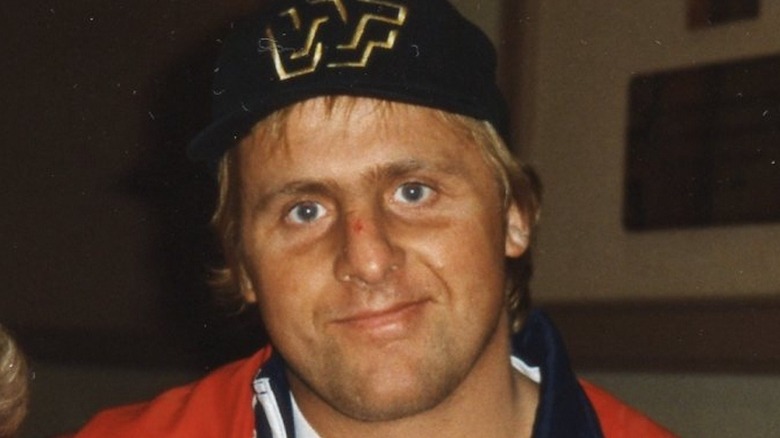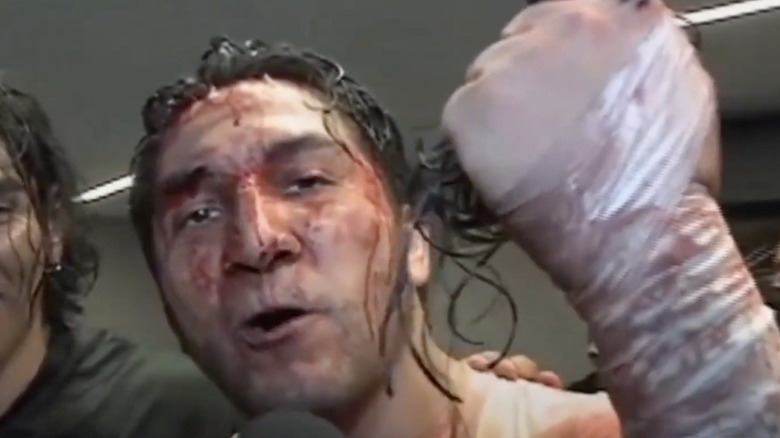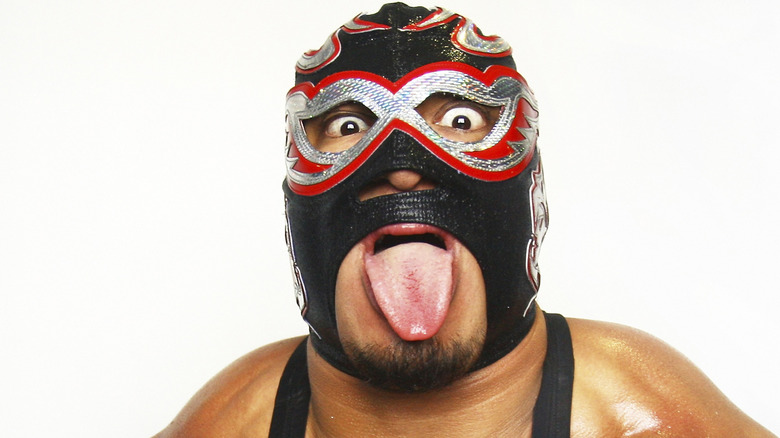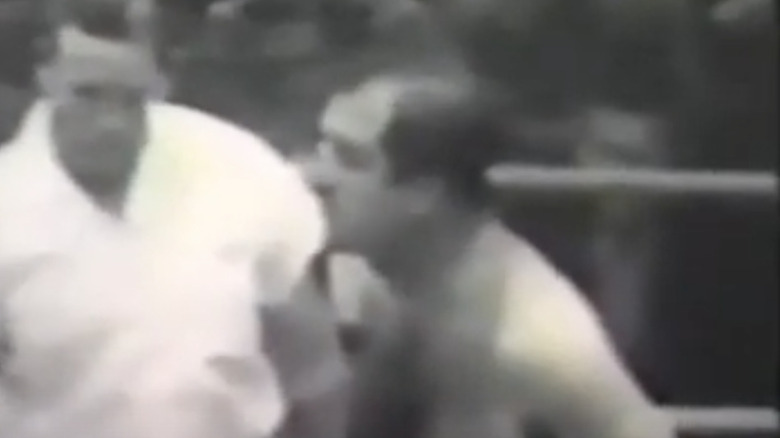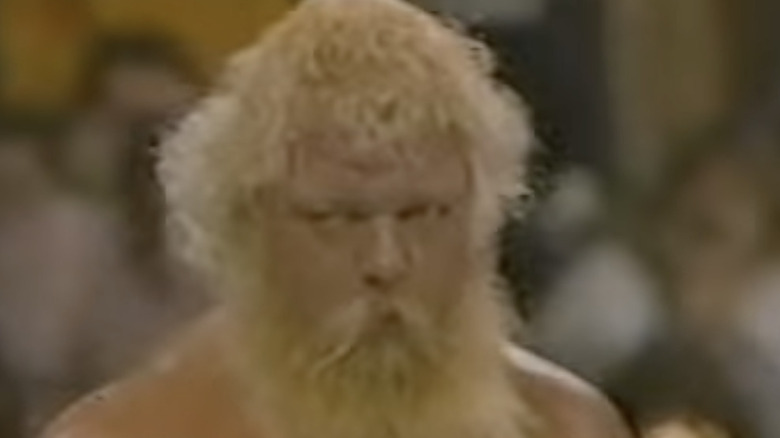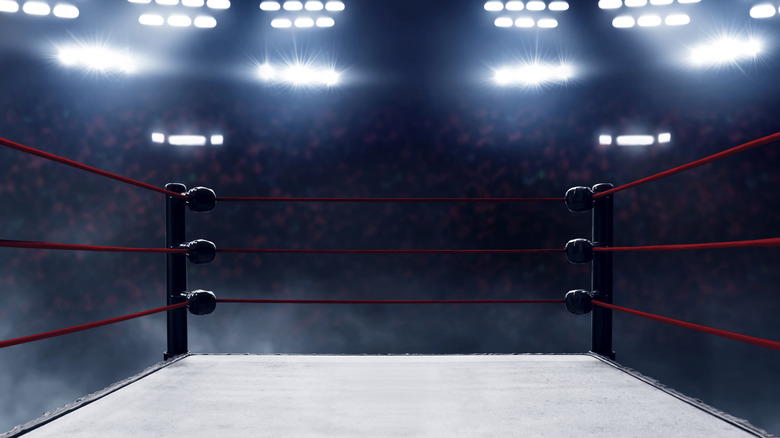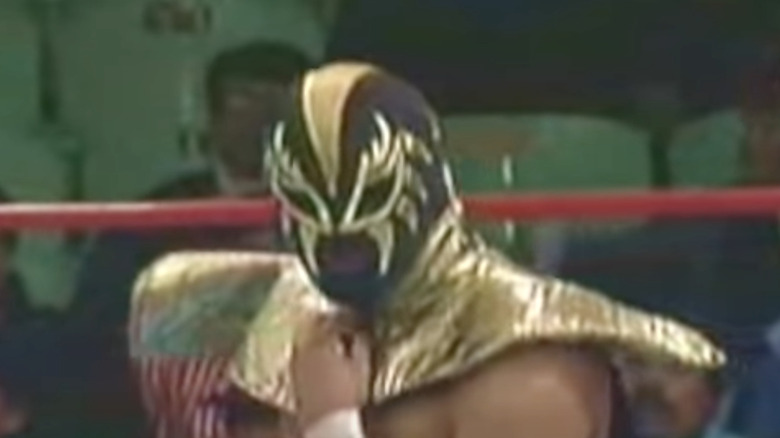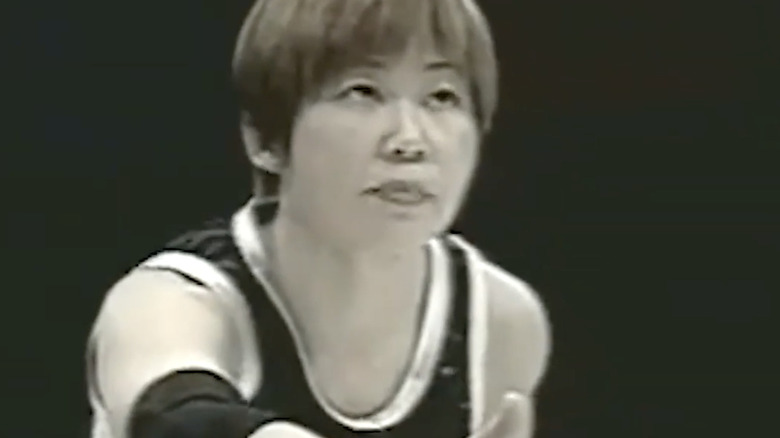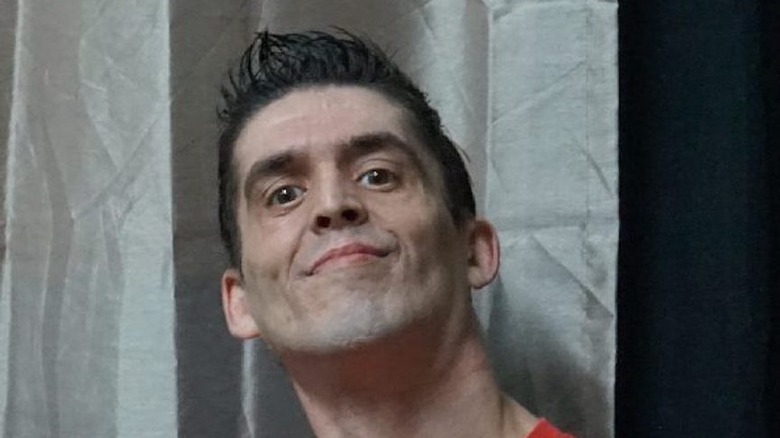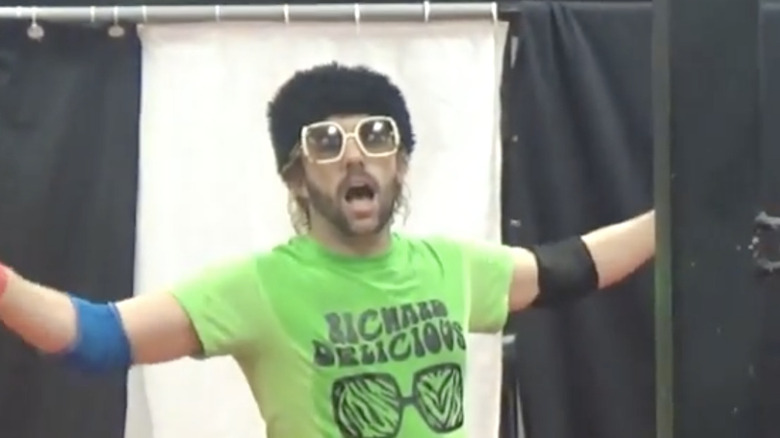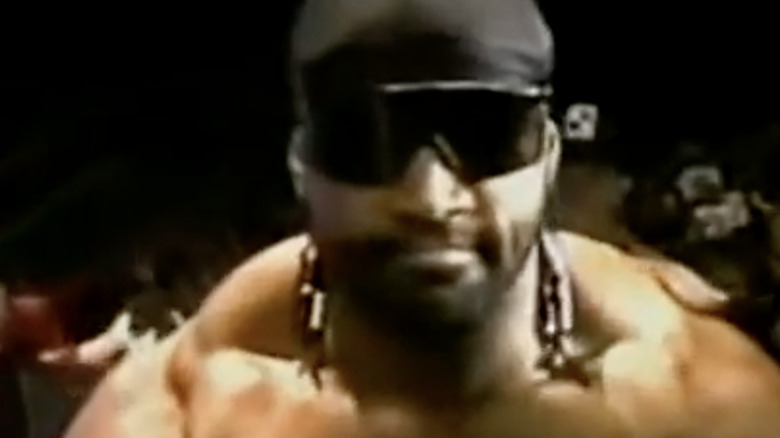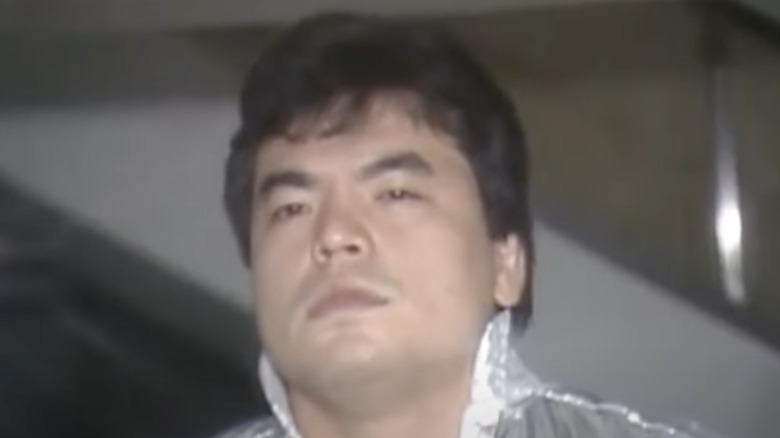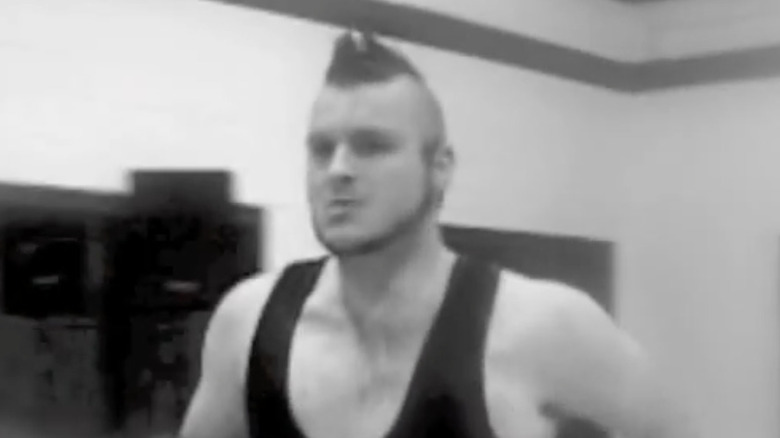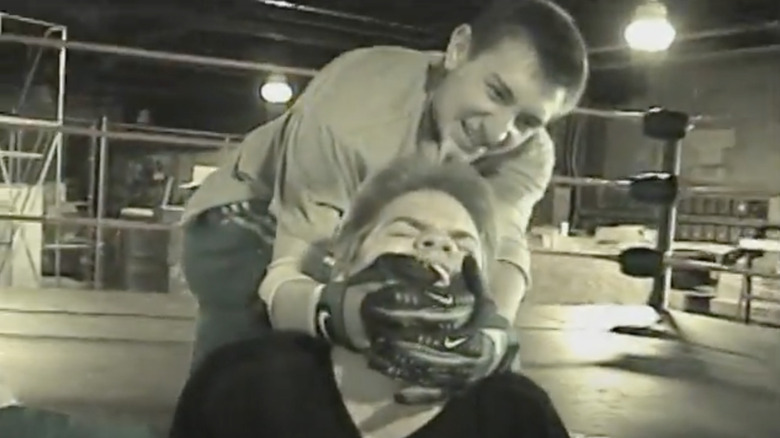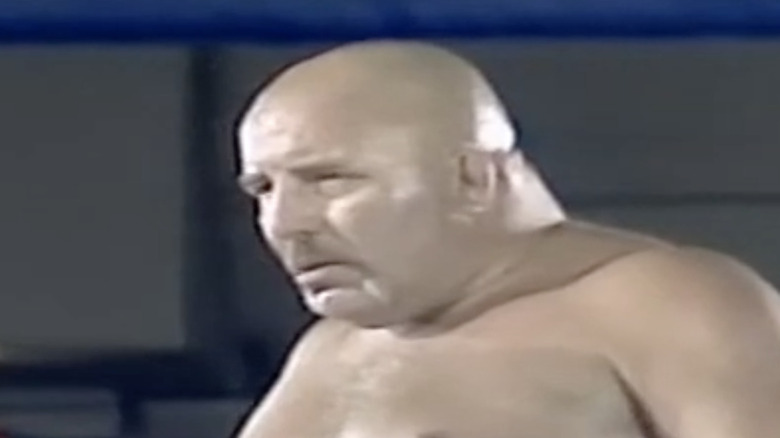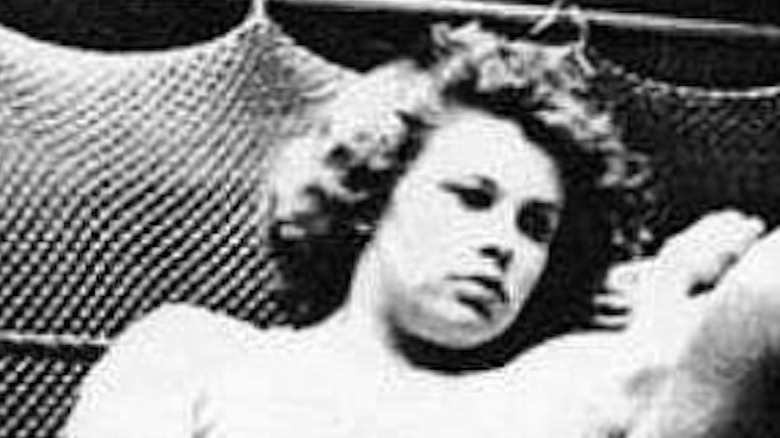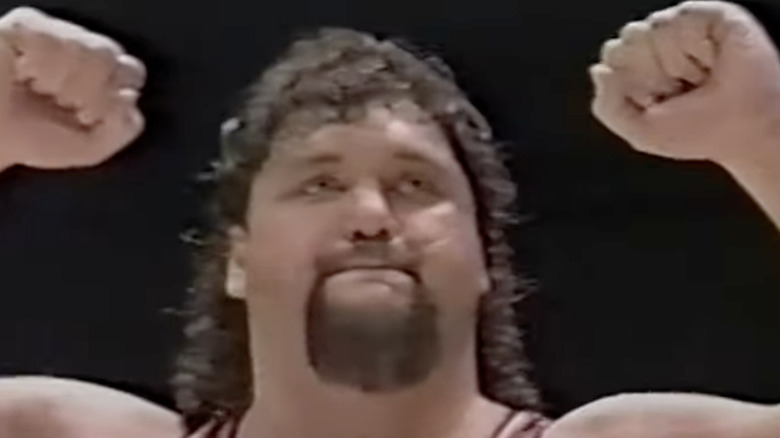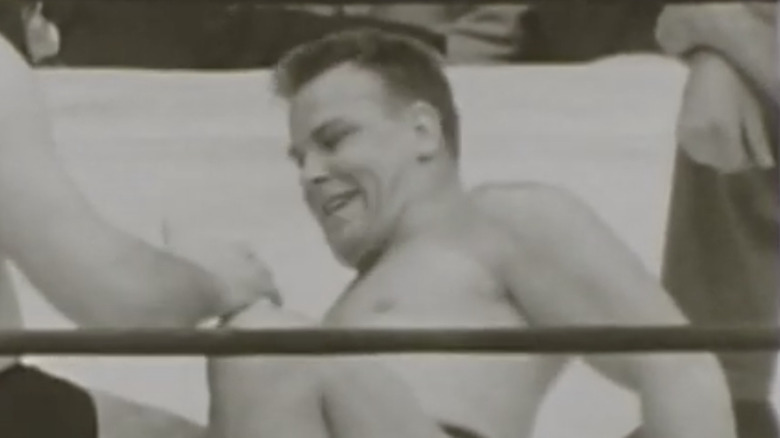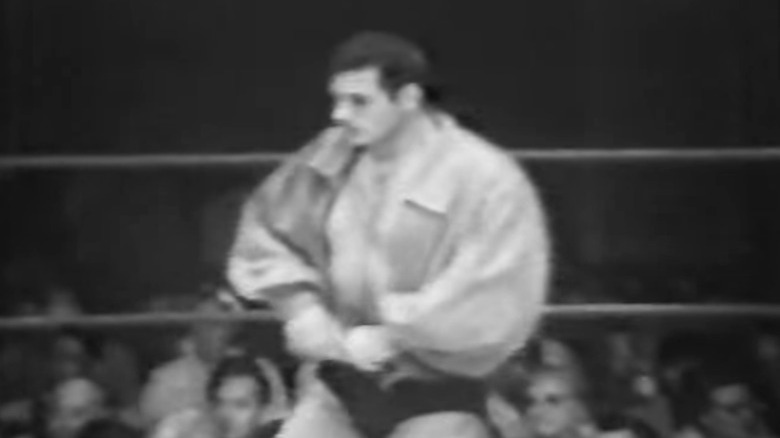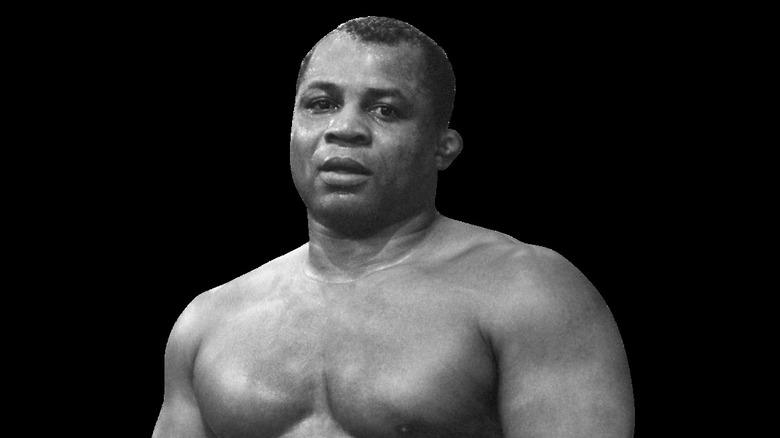Pro Wrestlers Who Passed Away In The Ring
Professional wrestling is not a sport for the faint of heart. Much like other combat sports such as boxing and mixed martial arts, pro wrestlers legitimately risk their lives on a nightly basis to entertain the masses. As a result, even the strongest athletes and most proficient wrestlers are prone to accidents, which can oftentimes have fatal consequences.
Premature death has long been a problem in the industry, however, many early deaths in pro wrestling can be chalked up to drugs and health issues stemming from a prolonged career in the ring. On a less frequent basis, one misstep can result in a wrestler losing their life in the ring, whether the fault lies squarely on themselves or their opponent. Emergency health events can also lead to disaster as, unlike most other athletes, many wrestlers will compete past their 50s, when health events such as strokes and heart attacks are more frequent.
Here are 21 pro wrestlers who passed away in the ring.
Perro Aguayo Jr.
Perro Aguayo Jr. was one of the most high-profile wrestlers to pass away in the ring in nearly a decade at the time of his death. As the son of the original "Perro Aguayo," the man known as Pedro Aguayo Ramírez outside the ring debuted as a 15-year-old in 1995 and frequently teamed with his father. He competed in AAA for eight years, then left for the rival Mexican promotion, CMLL. He wrestled for CMLL until 2008, then returned home to AAA for the final seven years of his career. He also received Wrestling Observer Rookie of the Year and ranked as high as eighth in the 2007 edition of the Pro Wrestling Illustrated (PWI) 500, second among Mexican wrestlers.
Aguayo wrestled his final match on March 20, 2015, a tag team match where he and Manik (TJ Perkins) took on Rey Mysterio Jr. and Xtreme Tiger for The Crash promotion in Tijuana. According to Mysterio in his A&E Biography, Aguayo was to end up in position for Mysterio's finishing sequence, the 619, but instead of getting caught up in the ropes, went through the ropes and down to the floor below. Still, Aguayo ended up properly placed for the 619, but Mysterio missed him when he wound up slouched over the ropes. When Konnan, who was in attendance that night, went to wake Aguayo up, the 35-year-old did not respond. He was pronounced dead at the Del Prado hospital, and found to have died from cervical spine trauma caused by Mysterio's dropkick. Upon landing in the ring ropes, the whiplash from the action snapped his neck and autopsy results showed Aguayo broke his C-1, C-2, and C-3 vertebrae, dying almost immediately as a result of a cardiac arrest due to a cervical stroke caused by the fractured vertebrae.
"We lost the biggest superstar that Mexico has ever seen," Mysterio told Justin Barrasso of Sports Illustrated. "There were so many plans moving forward that would have been incredible. When I meet great people in this industry, I like to let them know they are great human beings. Perro was definitely one of them. He was so warm-hearted, kind, and respectful. Just like there will never be another Eddie, there will never be another Perro."
Silver King
Silver King, a distinguished luchador known for his work both north and south of the border, died in the ring at 51 years old. Silver King grew up as the son of a high-profile wrestler, Dr. Wagner, putting him on a lifelong collision course with the pro wrestling industry. He made his debut in 1985, formed a tag team known as Los Cowboys alongside El Texano after losing his mask in 1990, then went to work for WCW for four years between 1997 and 2000. While in WCW, Silver King retained his cowboy character and competed regularly in the company's cruiserweight division. After WCW closed its doors, Silver King became the third wrestler to portray the Black Tiger character in New Japan Pro-Wrestling. Later, he wrestled for AJPW, AAA, and even starred opposite Jack Black in the 2006 comedy "Nacho Libre."
While wrestling familiar foe Juventud Guerrera in London, England on May 15, 2019, Silver King collapsed in the ring and died. The autopsy confirmed Silver King, real name César Cuauhtémoc González Barrón, died of a sudden myocardial infarction, a type of heart attack. A tribute show for Silver King was held on May 22, 2019.
Iron Mike DiBiase
Michael DiBiase, the stepfather of "The Million-Dollar Man" Ted DiBiase and grandfather of retired wrestlers Mike, Ted and Brett DiBiase, had his impressive career across the United States cut short at the age of 45. His death, which came as a result of a massive heart attack, is even more surprising considering how well-known DiBiase was for keeping himself in tremendous physical condition. He once competed against Dory Funk in a Texas Death match that lasted for four hours and 10 minutes, a match type similar to the Last Man Standing match but notorious for its excessive length.
The one-time AAU amateur wrestling champion of 1946, died in the ring on July 2, 1969, in Lubbock, Texas, immediately following a match with Man Mountain Mike. According to the Pro Wrestling Historical Society, Harley Race was the first person around ringside to notice something was wrong and immediately started administering CPR to DiBiase. Race rode with his colleague to the hospital where he was immediately pronounced dead.
"[My stepfather] had a storied career and he was a good dad," Ted DiBiase Sr. said of his stepfather in an interview with Fatherly. "One of the things he told me when I was very young was 'Don't follow the crowd.' He said, 'It takes no courage to do that. Be a leader, not a follower. Be the head, not the tail. If you work real hard, you can be anything you want. If you're willing to pay the price, make the sacrifices.' He never once bragged about that stuff. I always heard stories from other people about his college career and other achievements."
Ted DiBiase also stated in a shoot interview his stepfather's death came as a result of a cholesterol build-up in his heart, and that he had a propensity for future heart disease due to his genetics.
Moondog Spot
Moondog Spot, who also wrestled in the Memphis territory as Larry Latham, is one of several wrestlers on this list to have passed away as a result of a heart attack in the ring. Spot, real name Larry Booker, is best known for his run in the WWF as one-half of the Moondogs tag team alongside Moondog Rex. He had previously made up one-half of the Blonde Bombers in Memphis alongside Wayne Ferris, who later became The Honky Tonk Man in WWF. Together, Ferris and Latham earned notoriety for their feud with Jerry "The King" Lawler and Bill Dundee, and more specifically the "Tupelo Concession Stand Brawl" on June 15, 1979.
Booker, a native of Memphis, died in his hometown when he suffered a heart attack during a Memphis Championship Wrestling match on November 29, 2003. Booker, wrestling as Moondog Spot, had been competing in a "concession stand battle royal" at Lawler's "birthday bash" show but soon slumped himself in the corner of the ring. After realizing something was wrong with Booker, the wrestlers involved in the match brought it to a swift end as the paramedics swarmed the ring. Booker passed away upon arriving at the local medical facility. "From what I understand from one of the wrestlers, he went to hit Larry and grabbed him," MCW promoter Cory Macklin told the South Florida Sun-Sentinel. "When he grabbed [Booker] by the beard, he laid back and collapsed."
Brian Ong
Perhaps the most notable example of a wrestler dying as a result of another wrestler's action in the ring is when Brian Ong died during a match with Dalip Singh, who later rose to fame in WWE as The Great Khali. Little is known about Ong other than that he had been training to enter the business at the All Pro Wrestling Boot Camp in Hayward, California. On the day of his death in 2001, he wrestled Singh, a 7'3, 420 pound man who had been wrestling for only seven months himself.
During a training session, Khali hit Ong with a flapjack, a move where the wrestler on the receiving end of the move is supposed to land on their stomach. Instead, Ong came down awkwardly on his head, but received clearance to continue training that day from the APW medical team on site. He took another move from Singh and wound up dying as a result of the trauma to the head. He was 27. Ong's family sued APW and Singh for the wrongful death of the wrestling trainee and were awarded a sum of money north of one million dollars. APW's Roland Alexander, who passed away in 2013, told Colt Cabana on the "Art of Wrestling Podcast” that the school's liability insurance covered the judgment. As for Singh he was cleared of any wrongdoing, went on to have a successful eight-year run in WWE and has never spoken publicly on the matter.
Oro
Oro, real name Jesús Javier Hernández Silva, saw his wrestling career come to an abrupt end before it fully got rolling. The second-generation superstar's death came at the age of 21 and occurred during a six-man tag team match for EMLL (now CMLL) at the Arena Coliseo in Mexico City on October 26, 1993. Prior to the match, Oro told the five other wrestlers involved in the match – La Fiera, Brazo de Plata, Kahoz, Dr. Wagner Jr., and Jaque Mate — that he wanted to take a "Kobashi bump" to add dramatic effect. The type of bump Oro referred to was a head first backdrop driver that Kenta Kobashi took three times from "Dr. Death" Steve Williams less than a month prior in AJPW. During the match at Arena Coliseo, Oro landed on his head while attempting to sell a clothesline from Kahoz. When Kahoz went to raise his opponent to his feet, Oro collapsed to the mat and died before even reaching the ambulance. Since Oro's parents requested that an autopsy not be performed, he is believed to have died from a brain aneurysm.
The death of the promising 21-year-old sent shockwaves throughout the world of lucha libre, with rival promotion AAA even acknowledging it during a time where tensions ran high between the top two Mexican promotions. These days, Oro continues to be celebrated by the Mexican fans. The community gathers around the time of Oro's death every year to celebrate his life with a religious mass at Arena Coliseo, the place of his passing. The mass is meant to not only honor the life of Oro, but other major names in lucha libre who have since passed on.
Emiko Kado
Japanese wrestler Emiko Kado's brief in-ring career came to a tragic end on March 31, 1999. She teamed with Michiko Omukai to face Mariko Yoshida and Mikiko Futagami in a tag team match at Korakuen Hall in Tokyo, Japan, a big deal for a women's wrestler with just 15 matches in her brief career (and one exhibition) up to that point. Kado's career is also notable in that she never came out on the winning end of any of her matches.
Roughly 22 minutes into the match at Korakuen Hall, Kado suffered a serious injury from a blow to the head. Kado was rushed to a hospital in her hometown of Fukuoka, where she died from intracerebral bleeding on April 9,1999, less than two weeks after the match. According to Dave Meltzer of the Wrestling Observer Newsletter, she spent her final days in a coma and specifically died due to an acute sprained membrane in her brain. She was 23.
Eric Denis
Canadian Eric Denis, a father of six children at the time, collapsed in the ring at a charity show for his home promotion, ICW Fighting Federation, in Montreal on October 8, 2017. According to The Independent, the local medical team reportedly attempted to revive Denis, but he was pronounced dead upon his arrival at the hospital. A heart attack is his expected cause of death – Pat Laprade of Slam Wrestling reported Denis complained for a few weeks that he felt like there was a pressure point in his back, but chalked it up to a muscular spasm.
Danny Kidman, the head of ICW, commented to TVA Nouvelles about Denis' tragic passing. Kidman called the situation with Denis "terrible," while praising the medical staff for their diligent work as well as Denis for being an exceptional wrestler and father. Additionally, Denis came from a wrestling family in Montreal, as both his father and uncle used to be involved with ICW as both a manager and wrestler respectively.
Richard Delicious
Floridian independent wrestler Richard Delicious, real name Wayne VanDyke, passed away after collapsing during a match for Ronin Pro Wrestling on April 29, 2017. Sportskeeda reported that VanDyke, 29 at the time, told his partner that he wasn't feeling well during the match, and suffered a heart attack after tagging out.
Paramedics quickly arrived on the scene and administered CPR to VanDyke in an attempt to resuscitate him. However, VanDyke sustained broken ribs and a punctured lung while receiving CPR and suffered two more heart attacks at the hospital. VanDyke's family later confirmed his passing on Facebook.
Wrestling as Richard Delicious, VanDyke was a regular around the Florida independent scene and worked behind the scenes for a number of WWN promotions according to 411Mania. WWN also announced that all money raised beyond the expenses for their upcoming shows at the time would be donated towards VanDyke's medical bills.
Larry Cameron
"Lethal" Larry Cameron came to wrestling from the world of professional football. He made a name for himself in the Canadian Football League and even won the Grey Cup as a member of the Ottawa Rough Riders, but retired due to injuries and channeled his natural athleticism into a powerlifting career. When he later picked up pro wrestling, he learned the craft under famed trainer Eddie Sharkey and even took a trip up north to Calgary, Alberta, Canada to train in the Hart Dungeon alongside another former football player in Brian Pillman. Cameron made appearances in promotions such as AWA, NJPW, and WCW, and started to draw attention to himself as a future star in the sport.
Unfortunately, Cameron merely scratched the surface of his potential-laden career in wrestling, as he suffered a heart attack during a December 13, 1993 match against Tony St. Clair in Bremen, Germany. Cameron had been touring regularly in Europe as a member of Otto Wanz' Catch Wrestling Association (CWA). At the time of his passing, Cameron was also one-half of the CWA tag team champions alongside partner Anthony Durante. He was 41.
Mitsuharu Misawa
One of the greatest Japanese professional wrestlers of all time, Mitsuharu Misawa's career met a tragic end, but not before he embarked on one of the most accomplished careers in puroresu. Misawa burst onto the scene for his portrayal of Tiger Mask in the '80s. Upon unmasking in 1990, Misawa started competing under his real name and embarked on legendary feuds with the likes of Toshiaki Kawada and Jumbo Tsuruta before breaking off from AJPW to form Pro Wrestling NOAH. Between AJPW and NOAH, Misawa is an eight-time world champion in wrestling.
Despite having fought the "who's who" of puroresu and cultivated a unique legacy in the all-time landscape of the sport, Misawa never retired from the ring. The three-time Wrestling Observer Wrestler of the Year wrestled his final match in Hiroshima on June 13, 2009. Misawa teamed with Go Shiozaki to take on Bison Smith and Akitoshi Saito for the GHC Tag Team Championship. According to Cageside Seats, nearly 30 minutes into the match, Misawa took a back suplex from Saito, lost consciousness and was pronounced dead at Hiroshima University Hospital at the age of 46.
While Misawa's death is likely to have occurred on impact, his death appears to have had less to do with the final suplex he took from Saito and more to do with years of abusing his neck in matches. Still, fans harassed Saito and his family for his role in Misawa's death, even though Misawa's family publicly denounced Saito's responsibility for the incident.
Matt Lowry
Online World of Wrestling reported that Matt "Riot" Lowry, 21, had recently relocated to the east coast following the death of his mother in an attempt to go all-in on his true passion: pro wrestling. Per Wrestling News Source, "Matt Riot" worked for Absolute Intense Wrestling, the World Wrestling Coalition, American Luchacore, the Heartland Wrestling Association, and IWA Mid-South in the past, and planned to work for CZW in the future, as he and current Impact Wrestling star Sami Callihan were close friends at the time.
Lowry came to the famous ECW Arena in South Philadelphia for a training session on September 15, 2009. Before any intensive training got underway, Lowry reported dizziness, then collapsed in the ring during a break. After the local paramedics arrived on the scene, CZW Owner David Markland (better known to wrestling fans as DJ Hyde) and other wrestlers on the scene followed the ambulance to the hospital, then contacted Lowry's father back in Ohio. Lowry was declared dead 14 hours after arriving at the hospital due to a fatal brain hemorrhage sustained at an undetermined time.
Dan Spider Quirk
Tragedy struck on May 28, 2005 when independent wrestler Dan "Spider" Quirk met his tragic end as a result of a high spot that went awry. Quirk competed primarily out of Connecticut Championship Wrestling in his home state, and gained a love for wrestling through watching wrestlers such as Bret Hart, Mr. Perfect, and Marty Jannetty. His involvement with CCW reportedly extended beyond the ring according to PWInsider's Adam Dolan, as Quirk helped out in various ways behind the scenes and even ran the promotion's website.
Per WrestleZone, Quirk's death came during an Ultimate Championship Wrestling show in Taunton, Massachusetts. His opponent was unable to catch him during a high-risk moonsault, causing Quirk to crash to the floor headfirst. The trauma knocked Quirk out cold as blood began to surround him on the floor. As a result, the match immediately came to a halt as Quirk was taken in an ambulance to the local hospital, but all attempts to revive the 22-year-old proved unsuccessful.
Plum Mariko
The death of Japanese women's wrestler Plum Mariko marked the first known time an in-ring death occurred on the Japanese scene. Dave Meltzer of the Wrestling Observer Newsletter even compared the death of Emiko Kado in 1999 to Mariko's in 1997. However, in Mariko's case, doctors believed her death may have come as a result of multiple injuries as opposed to just one. Mike Lorefice of Quebrada reported in the days following Mariko's passing that the 29-year-old had been having problems such as forgetting the finish of matches, forgetting to run in to save her partners in tag team matches, not being able to memorize complicated sequences, and underperforming on routine moves she would not normally miss. These issues came as a result of a series of concussions Mariko sustained in her short career, a fact the higher-ups in JWP Joshi Puroresu were reportedly aware of.
The New York Times reported that Mariko's death occurred after she took a powerbomb during a match on August 15, 1997. Mariko teamed with Bolshoi Kid in a tag team match that night, working opposite of rivals Mayumi Ozaki and Rieko Amano at the Hiroshima Sun Plaza. The powerbomb, which was more specifically a Ligerbomb, knocked Mariko out cold and caused her to start snoring. The ambulance arrived on the scene as quickly as possible, but efforts to resuscitate Mariko fell short with brain damage being cited as the reason for her passing on August 16.
King Kong Kirk
Malcolm "King Kong" Kirk wrestled during an era of British wrestling when the biggest stars also happened to be the biggest people. The 350-pound Kirk was no exception, and he frequently worked alongside and against other massive wrestlers such as the 375-pound Shirley "Big Daddy" Crabtree and Giant Haystacks, who reportedly weighed as much as 686 pound during his career. As a former rugby player and coal miner, Kirk became notable for not needing a gimmick to propel his career, as he could just rely on natural intimidation to justify his place on the card.
Kirk's death came during a tag team match with King Kendo against Greg Valentine and Big Daddy on August 23, 1987 that otherwise felt par for the course until the finishing sequence took place. Big Daddy hit Kirk with the "Big Daddy Splashdown," a standing splash, but while he got up to celebrate, Kirk remained on the mat and began to turn purple. According to Vice, Kirk's heart "gave out on impact." He was immediately transported to the hospital, but pronounced dead on arrival to the shock of the wrestling world. He was 51.
The Health and Safety Executive later launched an investigation into Kirk's death and found him to have had a pre-existing heart condition exacerbated by the physical nature of pro wrestling. Due to the circumstances surrounding Kirk's death, Big Daddy garnered blame and made matters worse with his decision to give interviews about the match in character. Because of this, he came off as callous and dismissive, and drew criticism even though the Health and Safety Executive's investigation cleared him of any fault. Big Daddy has shown plenty of remorse over the situation in the years to follow, and evidence seems to indicate Kirk knew his time was running out. According to The Guardian, Kirk once told his friends, "If I have to go, I hope it is in the ring."
Jeanette Wolfe
Janet Wolfe, or Jeanette Wolfe as she was also known in wrestling circles, stands out as one of the youngest wrestlers to die in the ring. Wolfe is the adopted daughter of wrestling promoter Billy Wolfe, who also trained her, and women's wrestling pioneer Mildred Burke. Billy Wolfe training Janet and becoming her adopted father went hand in hand, as Billy needed to become Janet's legal guardian in order to train her, as she was 16-years-old at the time. Due to her association with such prominent players in the industry, Wolfe seemed destined to have a long career in wrestling.
Wolfe's final match took place on July 27, 1951, against Ella Walding in a benefit for the Shrine Club at Patterson Field Stadium in East Liverpool, Ohio. Walding slammed the undersized Wolfe on the mat with authority, which according to the coroner, likely ruptured her stomach. However, she complained of a headache before her second scheduled match of the night and wrestled for a few minutes before collapsing on the ring apron. Wolfe was rushed to the hospital but died the next day. In addition to the ruptured stomach, the coroner also found Wolfe to have sustained a brain hemorrhage due to a blood clot sustained in the days leading up to her death. While fans were quick to blame Walding for Wolfe's death, the incident led to improved notoriety for Walding, who told Slam Wrestling she started drawing "the biggest damn houses in the world."
Gary Albright
Gary Albright, a native of Rhode Island, seldom wrestled in the United States. However, his last match would occur in his home country at a World Xtreme Wrestling show in Hazleton, Pennsylvania. A talented amateur wrestler for the University of Nebraska, Albright quickly transitioned to a career in pro wrestling thanks to the advice of Lou Thesz, Billy Robinson and Danny Hodge, all of whom had a hand in the super heavyweight's training. Albright then spent the first two years of his career competing for Stampede Wrestling. From there, he spent more than two years making appearances in promotions all over the world before landing a permanent gig in Japan. Albright spent a combined nine years wrestling for two Japanese promotions: UWF International and All Japan Pro Wrestling.
Albright's death occurred on January 7, 2000 in a match against Lucifer Grimm. He collapsed to the mat after receiving a cutter from Grimm, reportedly suffering a heart attack. The Citizens' Voice, the local newspaper of Wilkes Barre, Pennsylvania reported the match came to a premature end at the 45-minute mark. The newspaper also reported that Albright suffered from an artery disease but did not mention any illnesses prior to the match with Grimm. As a result, the 36-year-old's death was deemed to have occurred due to natural causes.
Ray Gunkel
Wrestler-promoter Ray Gunkel may not have died directly in front of a live audience, but he did pass away in the immediate aftermath of a match where he sustained a legitimate chest injury. Upon entering the industry, the 6'3, 260-pound Gunkel brought with him an impressive athletic background as a former football player and wrestler at the University of Purdue. Gunkel the wrestler achieved All-American status and went undefeated over his junior and senior seasons and led the Boilermakers to two Big 10 Championships and himself to runner-up status at the national tournament. He immediately became a pro wrestler after graduating college and had a 24-year career competing primarily in the Texas and Georgia territories.
Gunkel wrestled for the final time on August 1, 1972 against Ox Baker in Savannah, Georgia and actually picked up a win over Baker in a rarity for wrestling-related deaths. When Baker went to deliver the Heart Punch, the impact created a hematoma in Gunkel's chest, which led to an eventual blood clot that rapidly worsened in the hours following their match until it reached his heart and killed him. The subsequent autopsy revealed that the 51-year-old territory star suffered from undiagnosed arteriosclerosis prior to stepping in the ring with Baker. However, Baker used the incident to his advantage in subsequent angles, making the Heart Punch one of the most devastating finishing moves of the period.
Alberto Torres
Ray Gunkel is not the only man Ox Baker was involved in the death of. Baker's match with Alberto Torres, which resulted in Torres' death, actually preceded the match with Gunkel by 14 months. Torres is best known for wrestling alongside brothers Ramon and Enrique Torres, having been trained by the latter.
The match between Torres and Baker happened on June 13, 1971. Torres collapsed during the match and was later found to have suffered a ruptured pancreas either before or during the match and soon died of internal bleeding a couple days later. Baker told the Orlando Sentinel he believed Torres to have had a bad heart. Just like the Gunkel case, however, Baker used Torres' death to make him an even more feared and loathed heel — although according to the Sentinel article, the decision to do so had more to do with the local promoter than Baker himself.
Luther Lindsay
Luther Lindsay, the first African-American to face a white man in the wrestling ring in Texas, is also notable for having died in the ring due to a massive heart attack. Before he died, Lindsay broke several race barriers in wrestling. He fought Lou Thesz to two time-limit draws and according to his WWE Hall of Fame profile, became the first African-American to challenge for what at the time was wrestling's most prestigious championship title. A legitimate shooter, Lindsay befriended Stu Hart while playing football in Calgary and trained under him at the Hart Dungeon. He also holds the distinction of being one of the few to have defeated Stu Hart in the Dungeon, according to Natalya Neidhart.
Much like Ray Gunkel, Lindsay won his last match, which occurred on February 21, 1972 at the Park Civic Center in Charlotte, North Carolina. He defeated Bobby Paul with a diving belly flop. Unlike Gunkel, however, Lindsay died on top of his opponent. When he did not respond to the referee after the match, paramedics took Lindsay backstage where he was pronounced dead at the age of 47. As tragic as the incident turned out to be, the day of Lindsay's death is overshadowed by his immense contributions to the sport. The influential legend has since been posthumously inducted into the Pro Wrestling Hall of Fame and the WWE Hall of Fame.
Owen Hart
The most infamous case of a pro wrestler dying in the ring occurred on May 23, 1999 when Owen Hart fell to his death at WWF Over the Edge 1999. The youngest son of Stu and Helen Hart competed all over the world, but became best known for his nine-year run in the WWF where he competed alongside and against his brother, Bret. The WWF utilized the younger Hart in a variety of roles before giving him his big break: a match against Bret at WrestleMania X that proceeded to both open and steal the show. Owen Hart not only gave a stellar account of himself that night, he beat his older brother clean in the middle of the ring, cementing himself as a name to watch out for in the coming years. Owen accomplished a ton over his distinguished career as a two-time WWF Intercontinental Champion, 1994 King of the Ring winner, and four-time WWF World Tag Team Champion with the help of three different partners.
Hart revived an old gimmick of his, the Blue Blazer, for a storyline involving then-tag team partner Jeff Jarrett. The storyline built to Over the Edge 1998 where Hart, wrestling as the Blue Blazer superhero character, was scheduled to take on The Godfather for the Intercontinental Championship. Hart prepared himself to make a superhero-esque entrance to the ring from the arena rafters at the Kemper Arena in Kansas City, Missouri. According to CNN, the harness system that was supposed to lower Hart to the ring malfunctioned on the way down, causing Hart to free fall 78 feet and hit the canvas with a sickening thud. Hart ultimately died of internal bleeding from blunt force trauma, resulting in one of the saddest days in the history of the business followed by an ugly aftermath laden with litigation and controversy.
